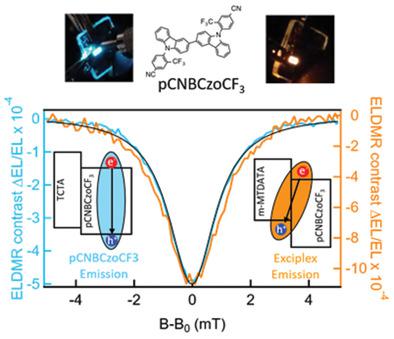当前位置:
X-MOL 学术
›
Adv. Electron. Mater.
›
论文详情
Our official English website, www.x-mol.net, welcomes your feedback! (Note: you will need to create a separate account there.)
Spin‐ and Voltage‐Dependent Emission from Intra‐ and Intermolecular TADF OLEDs
Advanced Electronic Materials ( IF 6.2 ) Pub Date : 2021-01-18 , DOI: 10.1002/aelm.202000702 Nikolai Bunzmann 1 , Benjamin Krugmann 1 , Sebastian Weissenseel 1 , Liudmila Kudriashova 1 , Khrystyna Ivaniuk 2 , Pavlo Stakhira 2 , Vladyslav Cherpak 2, 3 , Marian Chapran 4 , Gintare Grybauskaite‐Kaminskiene 5 , Juozas Vidas Grazulevicius 5 , Vladimir Dyakonov 1 , Andreas Sperlich 1
Advanced Electronic Materials ( IF 6.2 ) Pub Date : 2021-01-18 , DOI: 10.1002/aelm.202000702 Nikolai Bunzmann 1 , Benjamin Krugmann 1 , Sebastian Weissenseel 1 , Liudmila Kudriashova 1 , Khrystyna Ivaniuk 2 , Pavlo Stakhira 2 , Vladyslav Cherpak 2, 3 , Marian Chapran 4 , Gintare Grybauskaite‐Kaminskiene 5 , Juozas Vidas Grazulevicius 5 , Vladimir Dyakonov 1 , Andreas Sperlich 1
Affiliation

|
Organic light emitting diodes (OLEDs) based on thermally activated delayed fluorescence (TADF) utilize molecular systems with a small energy splitting between singlet and triplet states. This can either be realized in intramolecular charge transfer states of molecules with near‐orthogonal donor and acceptor moieties or in intermolecular exciplex states formed between a suitable combination of individual donor and acceptor materials. Here, 4,4′‐(9H,9′H‐[3,3′‐bicarbazole]‐9,9′‐diyl)bis(3‐(trifluoromethyl) benzonitrile) (pCNBCzoCF3) is investigated, which shows intramolecular TADF but can also form exciplex states in combination with 4,4′,4′′‐tris[phenyl(m‐tolyl)amino]triphenylamine (m‐MTDATA). Orange emitting exciplex‐based OLEDs additionally generate a sky‐blue emission from the intramolecular emitter with an intensity that can be voltage‐controlled. Electroluminescence detected magnetic resonance (ELDMR) is applied to study the thermally activated spin‐dependent triplet to singlet up‐conversion in operating devices. Thereby, intermediate excited states involved in OLED operation can be investigated and the corresponding activation energy for both, intra‐ and intermolecular based TADF can be derived. Furthermore, a lower estimate is given for the extent of the triplet wavefunction to be ≥ 1.2 nm. Photoluminescence detected magnetic resonance (PLDMR) reveals the population of molecular triplets in optically excited thin films. Overall, the findings allow to draw a comprehensive picture of the spin‐dependent emission from intra‐ and intermolecular TADF OLEDs.
中文翻译:

分子内和分子间TADF OLED的自旋和电压相关发射
基于热激活延迟荧光(TADF)的有机发光二极管(OLED)利用分子系统,在单重态和三重态之间具有很小的能量分配。这可以在具有接近正交的供体和受体部分的分子的分子内电荷转移状态中实现,也可以在单个供体和受体材料的合适组合之间形成的分子间激基复合物状态中实现。在此,4,4'-(9H,9'H- [3,3'-联咔唑] -9,9'-二基)双(3-(三氟甲基)苄腈)(pCNBCzoCF 3)进行了研究,它显示了分子内TADF,但也可以与4,4',4'-三[苯基(间甲苯基)氨基]三苯胺(m-MTDATA)结合形成激基态。发射橙色光的基于激基复合物的OLED还会从分子内发射器产生天蓝色发射,其强度可以控制电压。电致发光检测磁共振(ELDMR)用于研究操作设备中热激活自旋依赖性三重态到单重态上转换。因此,可以研究涉及OLED操作的中间激发态,并且可以导出基于分子内和分子间TADF的相应活化能。此外,对三重态波函数的范围≥1.2 nm给出了较低的估计。光致发光检测磁共振(PLDMR)揭示了光激发薄膜中分子三重态的总数。总体而言,这些发现可以对分子内和分子间TADF OLED自旋相关的发射进行全面描述。
更新日期:2021-03-11
中文翻译:

分子内和分子间TADF OLED的自旋和电压相关发射
基于热激活延迟荧光(TADF)的有机发光二极管(OLED)利用分子系统,在单重态和三重态之间具有很小的能量分配。这可以在具有接近正交的供体和受体部分的分子的分子内电荷转移状态中实现,也可以在单个供体和受体材料的合适组合之间形成的分子间激基复合物状态中实现。在此,4,4'-(9H,9'H- [3,3'-联咔唑] -9,9'-二基)双(3-(三氟甲基)苄腈)(pCNBCzoCF 3)进行了研究,它显示了分子内TADF,但也可以与4,4',4'-三[苯基(间甲苯基)氨基]三苯胺(m-MTDATA)结合形成激基态。发射橙色光的基于激基复合物的OLED还会从分子内发射器产生天蓝色发射,其强度可以控制电压。电致发光检测磁共振(ELDMR)用于研究操作设备中热激活自旋依赖性三重态到单重态上转换。因此,可以研究涉及OLED操作的中间激发态,并且可以导出基于分子内和分子间TADF的相应活化能。此外,对三重态波函数的范围≥1.2 nm给出了较低的估计。光致发光检测磁共振(PLDMR)揭示了光激发薄膜中分子三重态的总数。总体而言,这些发现可以对分子内和分子间TADF OLED自旋相关的发射进行全面描述。



























 京公网安备 11010802027423号
京公网安备 11010802027423号